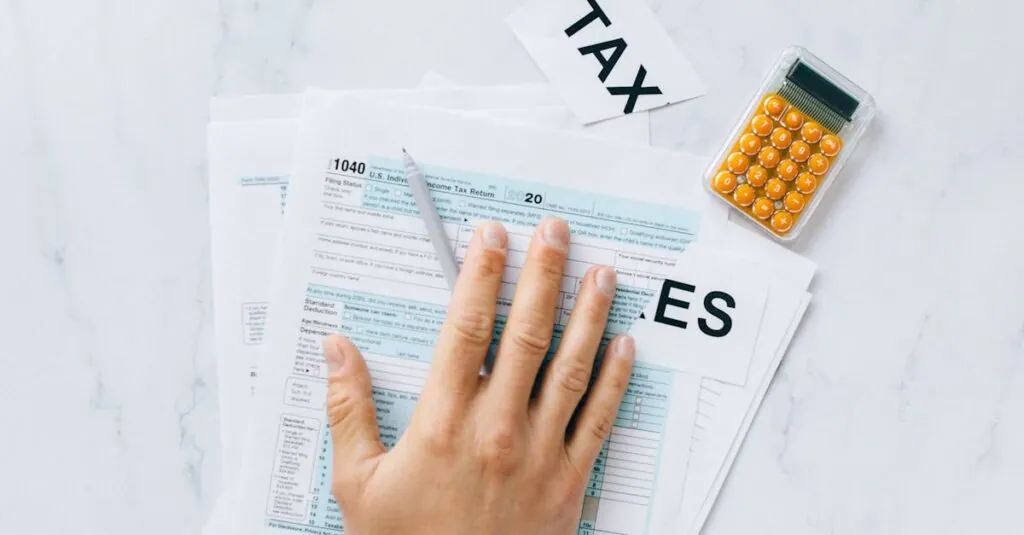Table of Contents
ToggleIn the world of finance, the federal balance sheet is like that mysterious family member who shows up at holidays—everyone knows they exist but few understand what they really do. This essential document holds the keys to understanding a nation’s financial health, revealing assets, liabilities, and the intricate dance of public debt.
Understanding the Federal Balance Sheet
The federal balance sheet plays a significant role in assessing a nation’s economic status. By providing insights into financial health, it reveals critical data regarding assets and liabilities.
Definition and Importance
A federal balance sheet represents the financial position of the government at a specific point in time. This document lists assets such as cash, securities, and property, alongside liabilities that include loans and obligations. Understanding this balance sheet is vital because it informs policymakers and citizens about fiscal sustainability and national debt levels. In turn, it influences economic decisions and investment strategies, shaping future financial policies and frameworks.
Key Components of the Balance Sheet
Key components include total assets, total liabilities, and net worth. Assets often consist of financial instruments and physical property, which are essential for generating revenue. Liabilities typically encompass debt obligations and other commitments, indicating the government’s financial responsibilities. Evaluating these components helps gauge economic stability and potential risks. The net worth, calculated by subtracting total liabilities from total assets, serves as an essential indicator of financial health. This snapshot allows for a clearer understanding of the overall economic landscape.
Historical Perspective
The federal balance sheet evolved significantly over time, reflecting broader economic conditions and policy shifts.
Trends Over Time
Since the late 20th century, trends reveal a consistent increase in both assets and liabilities. The balance sheet expanded as government operations grew, particularly during economic downturns. In the early 2000s, the federal debt accelerated, driven by factors including tax cuts and increased spending. Post-2008 financial crisis, the balance sheet witnessed unprecedented growth due to stimulus packages aimed at reviving the economy. Recent data indicates that total assets reached approximately $7 trillion by 2023, while liabilities stood at around $30 trillion, illustrating a growing fiscal challenge.
Impact of Economic Events
Economic events heavily influence the federal balance sheet, shaping its components and overall health. The 2008 financial crisis led to aggressive responses such as quantitative easing, inflating asset values significantly. Additionally, the COVID-19 pandemic prompted an expansion in fiscal measures, pushing liabilities higher through stimulus spending. Inflation spikes also affect liabilities by increasing interest payments on public debt. Each of these events underscores the importance of monitoring the balance sheet, as significant shifts can indicate broader economic implications and fiscal sustainability challenges.
Analyzing the Current Federal Balance Sheet
The federal balance sheet provides a snapshot of the country’s financial health, highlighting key figures regarding assets and liabilities.
Assets and Liabilities
Total assets currently approximate $7 trillion, comprising cash, securities, and federal property. Cash forms a significant portion of these assets, providing liquidity for government operations. Securities include government bonds that represent a safe investment and a claim on future revenues. Liabilities, conversely, total around $30 trillion and are primarily comprised of government debt and other obligations. Loans and pensions constitute major components of liabilities, which reflect ongoing financial commitments. The disparity between assets and liabilities signifies challenges toward fiscal stability, emphasizing the need for careful management.
Changes in Recent Years
Recent years showcased remarkable shifts in the federal balance sheet due to various economic events. Fiscal measures taken during the COVID-19 pandemic, for instance, led to significant increases in liabilities. By 2023, both assets and liabilities expanded considerably, driven by stimulus packages and relief efforts. Policymakers noted that increased spending during economic downturns directly impacted the balance sheet. The growth of liabilities prompted discussions about sustainability and potential ramifications for future economic stability. Monitoring these changes proves essential for assessing the nation’s financial landscape.
Implications of the Federal Balance Sheet
The federal balance sheet significantly affects economic health and policy decisions. A clear understanding of its implications enables effective governance and informed economic strategies.
Economic Policy Considerations
Economic policy decisions often hinge on data from the federal balance sheet. Policymakers assess assets and liabilities to determine fiscal strategies. For instance, rising liabilities may prompt a reevaluation of spending and revenue collection methods. Adjustments to social programs or tax policies frequently arise from this analysis. Growth in total assets can support investment initiatives, but must align with long-term fiscal sustainability goals. Prioritizing transparency fosters public trust and encourages dialogue around necessary economic reforms.
Effects on the National Debt
The federal balance sheet directly impacts the national debt’s trajectory. Total liabilities, currently around $30 trillion, indicate substantial commitments, drawing attention to repayment strategies. Increased liabilities can result from economic crises or stimulus measures, reflecting urgent fiscal needs. Government responses to national emergencies often spike borrowing, complicating future debt management. Debt sustainability hinges on generating sufficient revenue to counterbalance liabilities. Effective strategies could mitigate the risks associated with rising national debt, enhancing economic stability in the long run.
Understanding the federal balance sheet is critical for grasping a nation’s economic health. It reveals the intricate relationship between assets and liabilities while highlighting the challenges posed by rising national debt. The significant shifts resulting from economic events underscore the necessity for ongoing monitoring and analysis.
Policymakers and citizens alike must pay attention to this financial document as it shapes fiscal strategies and informs investment decisions. As the balance sheet continues to evolve, its implications for economic stability and sustainability will remain a pivotal concern for the future.




